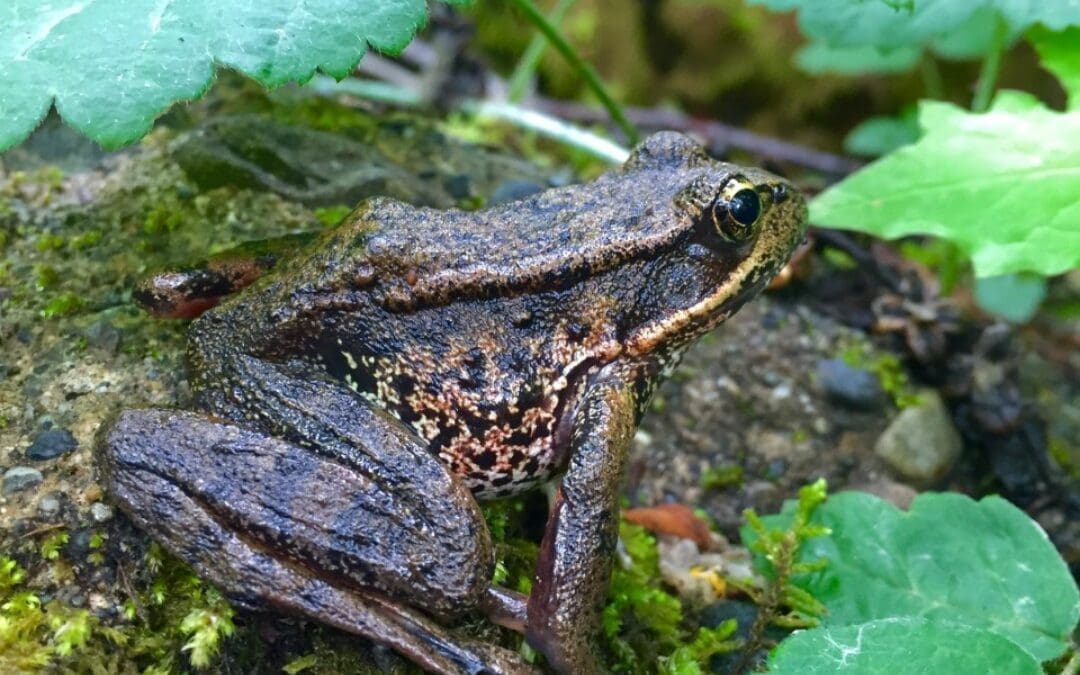The smallest frog in western Washington is also our most prolific, and has the widest distribution throughout the state. The Pacific Tree Frog, Psudacris regilla, is the only native frog species found in every county! This little frog is so abundant that it was made Washington’s state amphibian in 2007. Pacific Tree Frogs, also known as Pacific Chorus Frogs, gather in large numbers in early spring to mate. Each female will lay a mass of about 10-90 eggs. The males make their “ribit” sound by puffing up special air sacs in their throats up to three times the size of their heads. In large groups they can be quite loud, including near the Amphibian Pond at SHADOW.
We tend to think of them as little, green-skinned frogs, but they can also be brown, tan, reddish, or grey, with or without spots, with pale yellow bellies and a black stripe across their eyes. Unlike most frogs, they can change their skin color to match their surroundings, much like chameleons, although they do it much more slowly, taking several hours to several weeks. These skin color changes are triggered by changes in seasonal temperature and humidity. Green skin absorbs more solar radiation, so is beneficial in colder or aquatic habitats; brown skin reflects more solar radiation, and may be beneficial in drier, hotter, terrestrial habitats of summer. They are small, usually less than 2” long and their toes are only slightly webbed, but they have sticky pads on their toes to help them climb up plants in search of insects. They live in grasslands, forests, and mountains from sea level up to 10,000 feet in elevation, as long as there is a cover of vegetation and water nearby. Their natural range is from southern British Columbia to Baja, California, east to Nevada and Montana. They eat a variety of invertebrates, including mosquitoes, flies, ants, small spiders, isopods, and beetles and their chief predators are diving beetles, giant water bugs, certain fish species, garter snakes, and Bullfrogs.

Compared to the Pacific Tree Frog, the American Bullfrog, Lithobates catesbeianus, is huge. Bullfrogs are the largest frog species in North America. Males tend to be a bit larger than females, measuring 3-1/2 to 6” long, and can weigh over a pound. Their skin is olive-green, with or without greyish-brown patterning. Their bellies are whitish patterned with yellow or grey and their front toes are not webbed, but their back toes are. They are voracious hunters of any prey animal that will fit in their mouth, including rodents, lizards, snakes, bats, large insects, spiders, snails, worms, crayfish, other frogs and amphibians and their eggs, and small birds, including hummingbirds. If the captured prey is too large to fit in their mouth, they stuff it in with their front feet.
Bullfrogs are the state amphibian of Missouri, Ohio, and Oklahoma, and are native to the eastern, great plains, and southeastern United States, where natural predators include Great Blue Herons and River Otters, and Alligators. Humans have spread Bullfrogs to areas west of the Rocky Mountains where they have fewer predators and are able to out-compete and prey on the smaller amphibian species native to the area. They are also able to inhabit poor-quality ponds and streams and produce masses of up to 20,000 eggs. Their lifespan is in the wild is typically 8-10 years, considerably longer than our Pacific Tree Frog which live 5-7 years.
(Other frogs who make their home in parts of Washington: Northern Leopard Frog, Rana pipiens, found in Eastern Washington; Cascades Frog, Rana cascadae, Olympic and Cascades Mountains; Columbia Spotted Frog, Rana luteiventris, Cascades Mountains and eastern Washington; Oregon Spotted Frog, Rana pretiosa, Black River and Conboy Lake; Rocky Mountain Tailed Frog, Ascaphus montanus, Southeast corner of Washington. Coastal Tailed Frog, Ascaphus truei, found throughout western Washington. What about the toads? Western Toad, Anaxyrus boreas, found throughout Washington, except the southeast corner of the state. Woodhouse’s Toad, Anaxyrus woodhousi, southwestern Washington; and Great Basin Spadefoot Toad, Spea intermontana, only east of the cascades.)
By: SHADOW intern, Shelley Pasco



Recent Comments